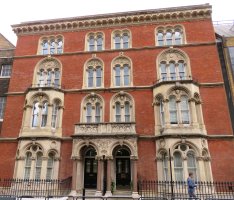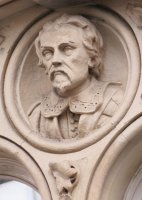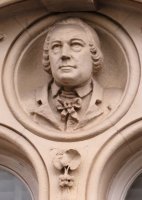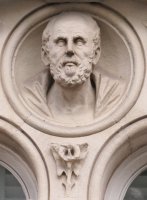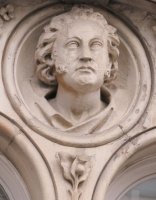Keats House, Guys' Hospital, South London
Just down St Thomas Street from Guys' Hospital is a red brick and white stone building four storeys high, which is called Keats House. Four storeys high, tending to Renaissance rather than Queen Anne style, it has carved floral decoration to the portico, roundels with portrait heads to the first floor windows, and more flowers and leaves at the third floor above the windows, along with more minor decorative carving, principally on the capitals to the windows of all floors. The leaves are well composed, crisply cut, typical, competent pattern book stuff of the later 19th Century.
Portrait busts on the frontage of Keats House.
The four busts are not named, and show, from left as we look at the building, a Shakespearian man with trimmed beard and wide collar, a plump-faced man of the 18th or 19th Century, a Classical bust of a bearded, balding ancient, and a younger, beardless man, with swept back locks of hair, and sideburns, wearing a cloak rather than collar, who is some Romantic-styled portrait bust of the 19th Century. Speculations on who they are rests either on the name of the building as Keats House, or its location and use associated with medicine, thus either poets or medics. So if poets, we might have Keats himself as the dashing youth, a Shakespeare (not the standard one, but there are other busts representing him which are not), a Homer or Hesiod or some other ancient Greek, and any one of a number of 18th Century poets. Or alternatively the ancient could represent Hippocrates, father of medicine, Thomas Guy, and Harvey and Paston or other medical personages. However, in the absence of inscriptions, identification with a specific portrait statue, or identifying accoutrements, we can only guess.
The sculptor however, has been identified by the sculptural scholar Terry Cavanagh as J.W. Seale, a Lambeth sculptor, one of several sculptors of that surname, of whom the most significant is Gilbert Seale, who has several pieces of architectural sculpture around London.
The preservation of the portrait heads is pretty good, with little more than pock-marking to the surface. We can ascribe this to the hard-wearing terra cotta, and the thoughtful placing of the busts well under arches, recessed somewhat in their roundels, and with projecting keystones above, thus well shielded from wind and rain, and without room for birds to perch comfortably atop the heads. A look at the carving on the tops of the pillars underneath shows a greater degree of damage to these more exposed surfaces.
The central portico.
Go southwards to another decorated building, the London Leather Exchange; west to Borough High Street and Red Cross Garden; or south west to St George the Martyr, with monuments, or east to Tooley Street. See also the page Borough to Bermondsey.
